Economic Analysis of Singapore: GDP, Unemployment, and Prices
VerifiedAdded on 2023/04/23
|13
|3079
|305
Report
AI Summary
This report provides a detailed analysis of Singapore's economic performance from 2004 to 2015, focusing on key indicators such as GDP, labor market dynamics, and inflation rates. The analysis includes a review of real GDP, GDP growth rate, and per capita GDP, highlighting the manufacturing sector's contribution and the impact of foreign labor. The labor market analysis examines unemployment rates, distinguishing between voluntary and involuntary unemployment, and identifies structural, frictional, seasonal, and cyclical types of unemployment prevalent in Singapore. Furthermore, the report investigates price levels and inflation, exploring the causes of inflation, including cost-push and demand-pull factors. Government measures to address economic challenges are also discussed, providing a comprehensive overview of Singapore's economic landscape during the specified period. This document is available on Desklib, where students can find similar resources and study tools.

Running head: ECONOMICS
Economics
Name of the university
Name of the student
Author note
Economics
Name of the university
Name of the student
Author note
Paraphrase This Document
Need a fresh take? Get an instant paraphrase of this document with our AI Paraphraser
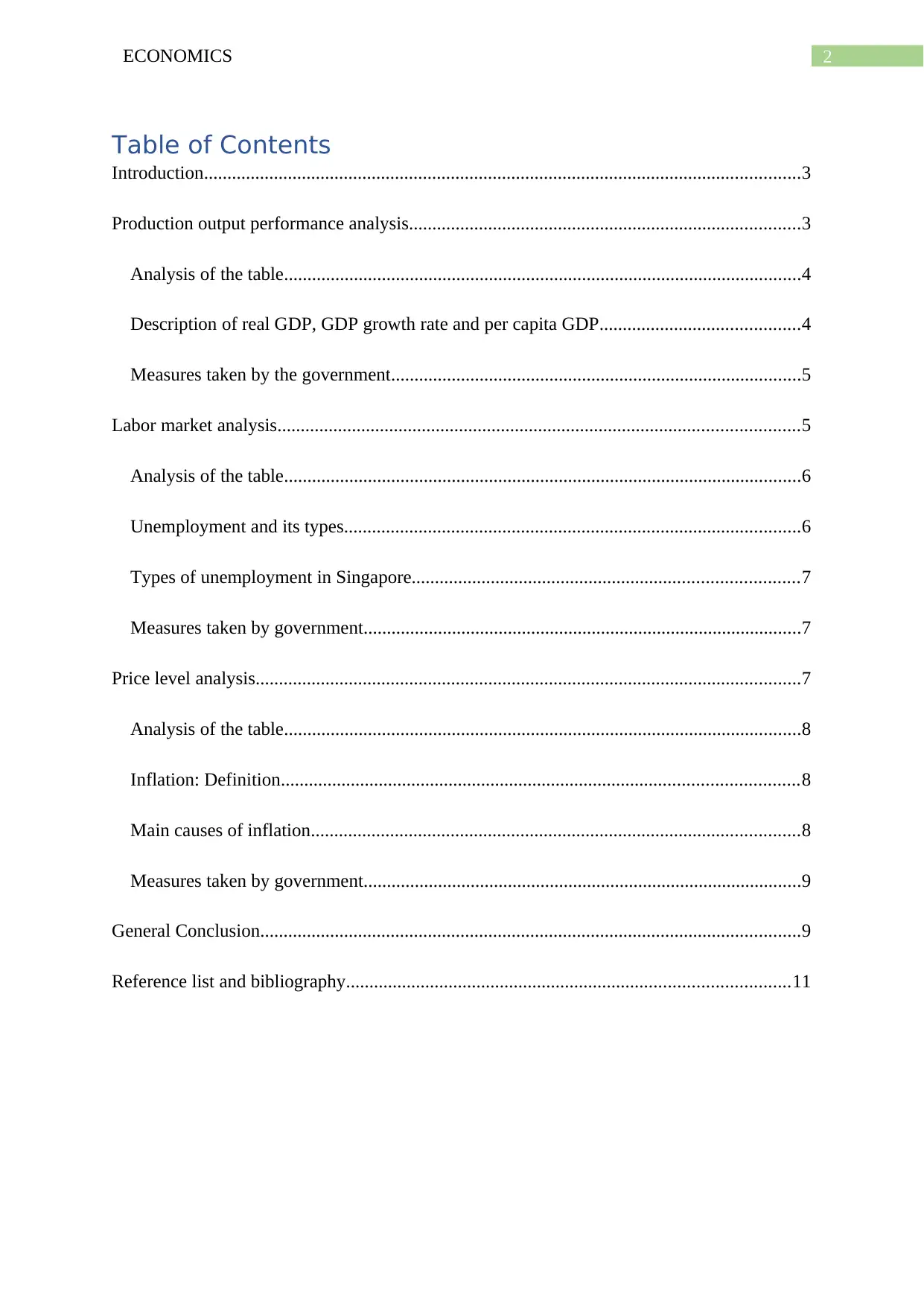
2ECONOMICS
Table of Contents
Introduction................................................................................................................................3
Production output performance analysis....................................................................................3
Analysis of the table...............................................................................................................4
Description of real GDP, GDP growth rate and per capita GDP...........................................4
Measures taken by the government........................................................................................5
Labor market analysis................................................................................................................5
Analysis of the table...............................................................................................................6
Unemployment and its types..................................................................................................6
Types of unemployment in Singapore...................................................................................7
Measures taken by government..............................................................................................7
Price level analysis.....................................................................................................................7
Analysis of the table...............................................................................................................8
Inflation: Definition...............................................................................................................8
Main causes of inflation.........................................................................................................8
Measures taken by government..............................................................................................9
General Conclusion....................................................................................................................9
Reference list and bibliography...............................................................................................11
Table of Contents
Introduction................................................................................................................................3
Production output performance analysis....................................................................................3
Analysis of the table...............................................................................................................4
Description of real GDP, GDP growth rate and per capita GDP...........................................4
Measures taken by the government........................................................................................5
Labor market analysis................................................................................................................5
Analysis of the table...............................................................................................................6
Unemployment and its types..................................................................................................6
Types of unemployment in Singapore...................................................................................7
Measures taken by government..............................................................................................7
Price level analysis.....................................................................................................................7
Analysis of the table...............................................................................................................8
Inflation: Definition...............................................................................................................8
Main causes of inflation.........................................................................................................8
Measures taken by government..............................................................................................9
General Conclusion....................................................................................................................9
Reference list and bibliography...............................................................................................11
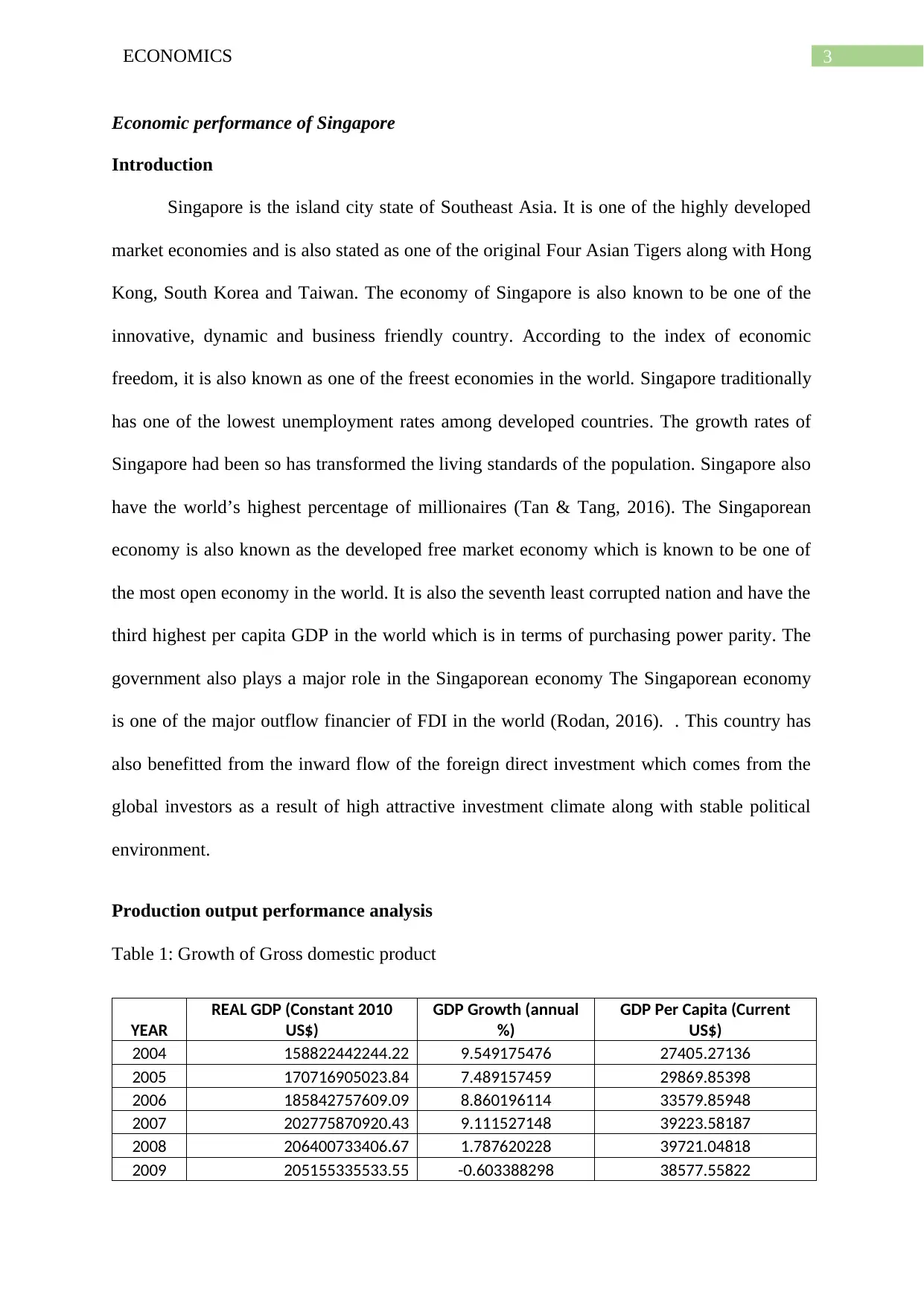
3ECONOMICS
Economic performance of Singapore
Introduction
Singapore is the island city state of Southeast Asia. It is one of the highly developed
market economies and is also stated as one of the original Four Asian Tigers along with Hong
Kong, South Korea and Taiwan. The economy of Singapore is also known to be one of the
innovative, dynamic and business friendly country. According to the index of economic
freedom, it is also known as one of the freest economies in the world. Singapore traditionally
has one of the lowest unemployment rates among developed countries. The growth rates of
Singapore had been so has transformed the living standards of the population. Singapore also
have the world’s highest percentage of millionaires (Tan & Tang, 2016). The Singaporean
economy is also known as the developed free market economy which is known to be one of
the most open economy in the world. It is also the seventh least corrupted nation and have the
third highest per capita GDP in the world which is in terms of purchasing power parity. The
government also plays a major role in the Singaporean economy The Singaporean economy
is one of the major outflow financier of FDI in the world (Rodan, 2016). . This country has
also benefitted from the inward flow of the foreign direct investment which comes from the
global investors as a result of high attractive investment climate along with stable political
environment.
Production output performance analysis
Table 1: Growth of Gross domestic product
YEAR
REAL GDP (Constant 2010
US$)
GDP Growth (annual
%)
GDP Per Capita (Current
US$)
2004 158822442244.22 9.549175476 27405.27136
2005 170716905023.84 7.489157459 29869.85398
2006 185842757609.09 8.860196114 33579.85948
2007 202775870920.43 9.111527148 39223.58187
2008 206400733406.67 1.787620228 39721.04818
2009 205155335533.55 -0.603388298 38577.55822
Economic performance of Singapore
Introduction
Singapore is the island city state of Southeast Asia. It is one of the highly developed
market economies and is also stated as one of the original Four Asian Tigers along with Hong
Kong, South Korea and Taiwan. The economy of Singapore is also known to be one of the
innovative, dynamic and business friendly country. According to the index of economic
freedom, it is also known as one of the freest economies in the world. Singapore traditionally
has one of the lowest unemployment rates among developed countries. The growth rates of
Singapore had been so has transformed the living standards of the population. Singapore also
have the world’s highest percentage of millionaires (Tan & Tang, 2016). The Singaporean
economy is also known as the developed free market economy which is known to be one of
the most open economy in the world. It is also the seventh least corrupted nation and have the
third highest per capita GDP in the world which is in terms of purchasing power parity. The
government also plays a major role in the Singaporean economy The Singaporean economy
is one of the major outflow financier of FDI in the world (Rodan, 2016). . This country has
also benefitted from the inward flow of the foreign direct investment which comes from the
global investors as a result of high attractive investment climate along with stable political
environment.
Production output performance analysis
Table 1: Growth of Gross domestic product
YEAR
REAL GDP (Constant 2010
US$)
GDP Growth (annual
%)
GDP Per Capita (Current
US$)
2004 158822442244.22 9.549175476 27405.27136
2005 170716905023.84 7.489157459 29869.85398
2006 185842757609.09 8.860196114 33579.85948
2007 202775870920.43 9.111527148 39223.58187
2008 206400733406.67 1.787620228 39721.04818
2009 205155335533.55 -0.603388298 38577.55822
⊘ This is a preview!⊘
Do you want full access?
Subscribe today to unlock all pages.

Trusted by 1+ million students worldwide
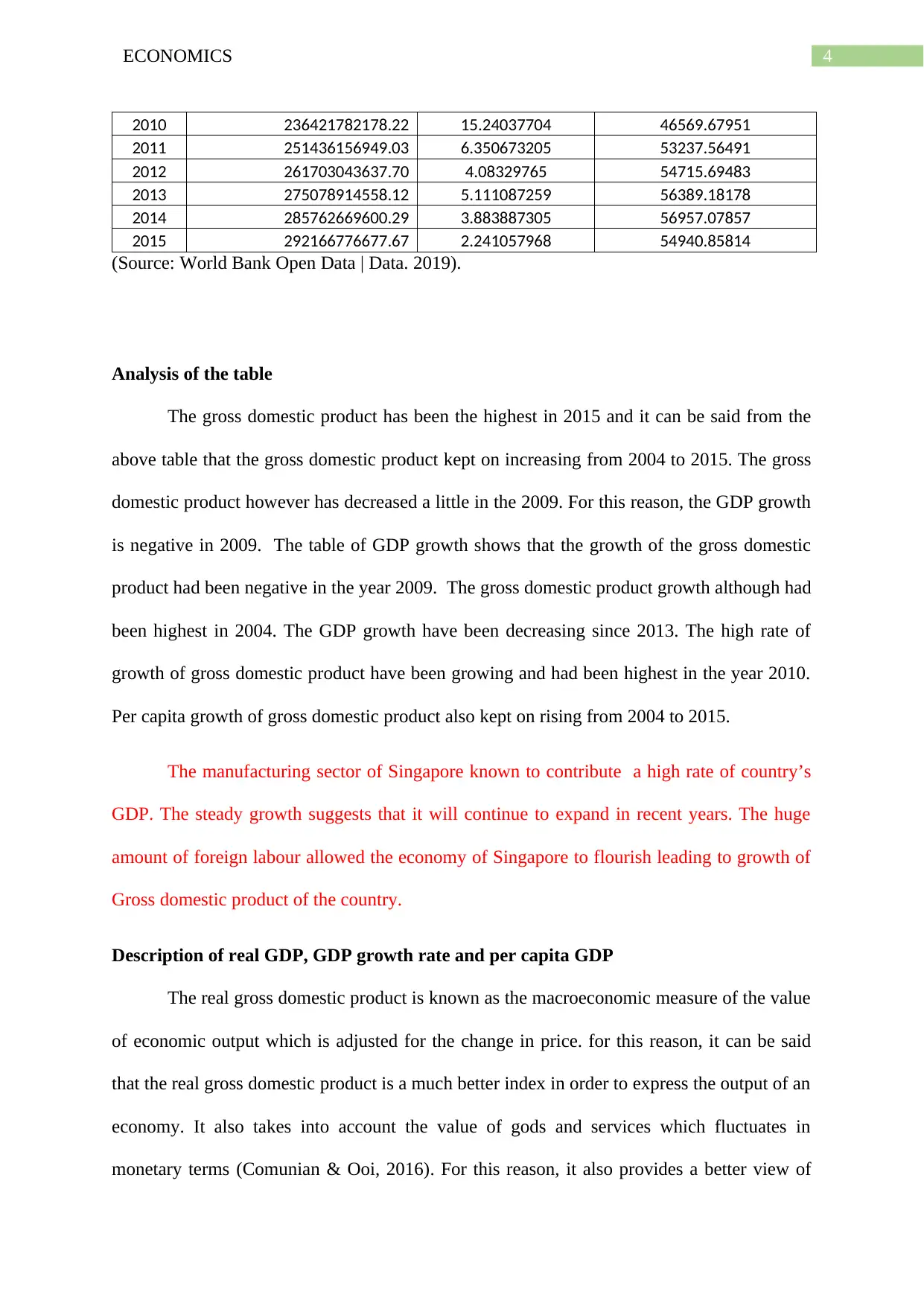
4ECONOMICS
2010 236421782178.22 15.24037704 46569.67951
2011 251436156949.03 6.350673205 53237.56491
2012 261703043637.70 4.08329765 54715.69483
2013 275078914558.12 5.111087259 56389.18178
2014 285762669600.29 3.883887305 56957.07857
2015 292166776677.67 2.241057968 54940.85814
(Source: World Bank Open Data | Data. 2019).
Analysis of the table
The gross domestic product has been the highest in 2015 and it can be said from the
above table that the gross domestic product kept on increasing from 2004 to 2015. The gross
domestic product however has decreased a little in the 2009. For this reason, the GDP growth
is negative in 2009. The table of GDP growth shows that the growth of the gross domestic
product had been negative in the year 2009. The gross domestic product growth although had
been highest in 2004. The GDP growth have been decreasing since 2013. The high rate of
growth of gross domestic product have been growing and had been highest in the year 2010.
Per capita growth of gross domestic product also kept on rising from 2004 to 2015.
The manufacturing sector of Singapore known to contribute a high rate of country’s
GDP. The steady growth suggests that it will continue to expand in recent years. The huge
amount of foreign labour allowed the economy of Singapore to flourish leading to growth of
Gross domestic product of the country.
Description of real GDP, GDP growth rate and per capita GDP
The real gross domestic product is known as the macroeconomic measure of the value
of economic output which is adjusted for the change in price. for this reason, it can be said
that the real gross domestic product is a much better index in order to express the output of an
economy. It also takes into account the value of gods and services which fluctuates in
monetary terms (Comunian & Ooi, 2016). For this reason, it also provides a better view of
2010 236421782178.22 15.24037704 46569.67951
2011 251436156949.03 6.350673205 53237.56491
2012 261703043637.70 4.08329765 54715.69483
2013 275078914558.12 5.111087259 56389.18178
2014 285762669600.29 3.883887305 56957.07857
2015 292166776677.67 2.241057968 54940.85814
(Source: World Bank Open Data | Data. 2019).
Analysis of the table
The gross domestic product has been the highest in 2015 and it can be said from the
above table that the gross domestic product kept on increasing from 2004 to 2015. The gross
domestic product however has decreased a little in the 2009. For this reason, the GDP growth
is negative in 2009. The table of GDP growth shows that the growth of the gross domestic
product had been negative in the year 2009. The gross domestic product growth although had
been highest in 2004. The GDP growth have been decreasing since 2013. The high rate of
growth of gross domestic product have been growing and had been highest in the year 2010.
Per capita growth of gross domestic product also kept on rising from 2004 to 2015.
The manufacturing sector of Singapore known to contribute a high rate of country’s
GDP. The steady growth suggests that it will continue to expand in recent years. The huge
amount of foreign labour allowed the economy of Singapore to flourish leading to growth of
Gross domestic product of the country.
Description of real GDP, GDP growth rate and per capita GDP
The real gross domestic product is known as the macroeconomic measure of the value
of economic output which is adjusted for the change in price. for this reason, it can be said
that the real gross domestic product is a much better index in order to express the output of an
economy. It also takes into account the value of gods and services which fluctuates in
monetary terms (Comunian & Ooi, 2016). For this reason, it also provides a better view of
Paraphrase This Document
Need a fresh take? Get an instant paraphrase of this document with our AI Paraphraser
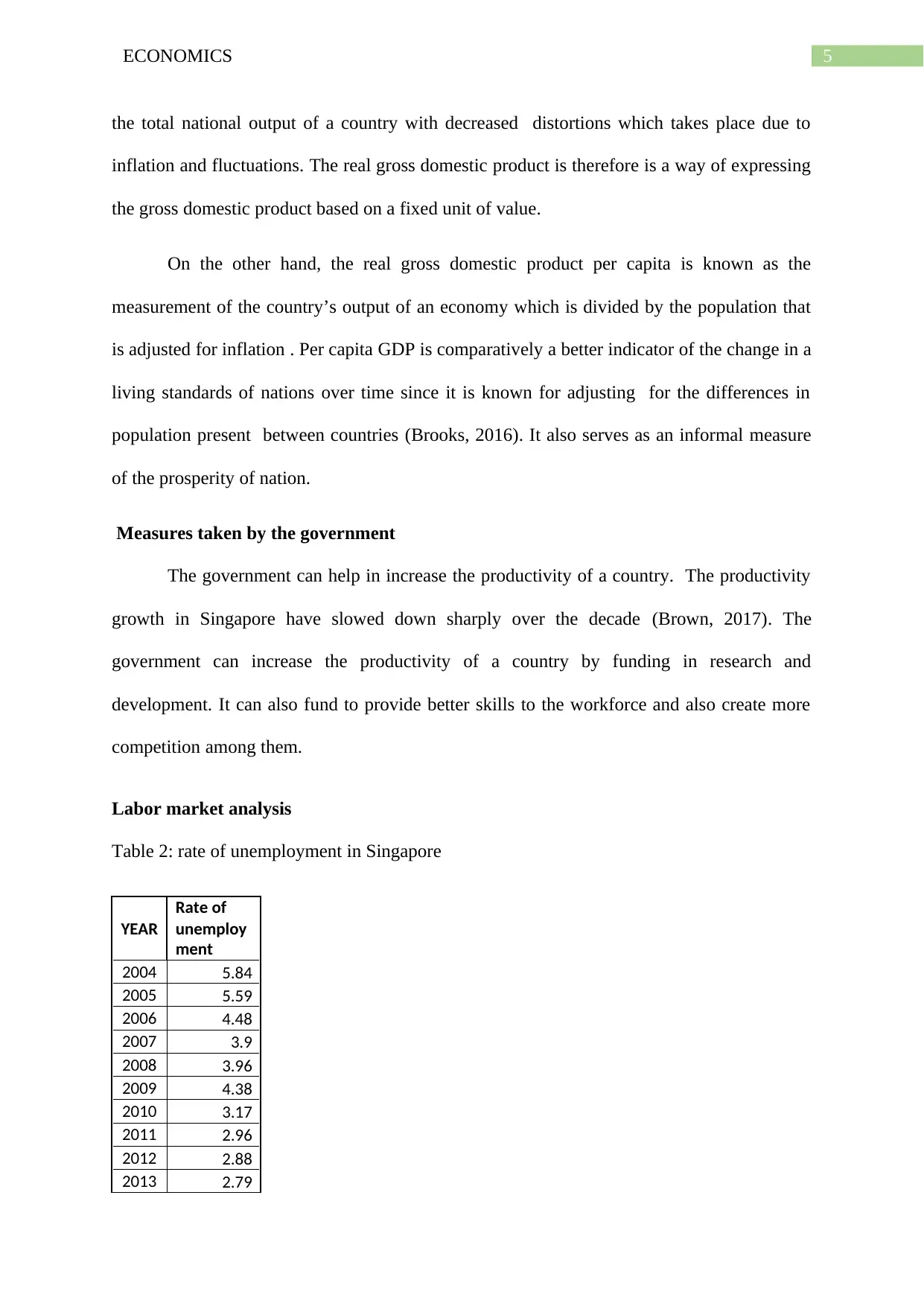
5ECONOMICS
the total national output of a country with decreased distortions which takes place due to
inflation and fluctuations. The real gross domestic product is therefore is a way of expressing
the gross domestic product based on a fixed unit of value.
On the other hand, the real gross domestic product per capita is known as the
measurement of the country’s output of an economy which is divided by the population that
is adjusted for inflation . Per capita GDP is comparatively a better indicator of the change in a
living standards of nations over time since it is known for adjusting for the differences in
population present between countries (Brooks, 2016). It also serves as an informal measure
of the prosperity of nation.
Measures taken by the government
The government can help in increase the productivity of a country. The productivity
growth in Singapore have slowed down sharply over the decade (Brown, 2017). The
government can increase the productivity of a country by funding in research and
development. It can also fund to provide better skills to the workforce and also create more
competition among them.
Labor market analysis
Table 2: rate of unemployment in Singapore
YEAR
Rate of
unemploy
ment
2004 5.84
2005 5.59
2006 4.48
2007 3.9
2008 3.96
2009 4.38
2010 3.17
2011 2.96
2012 2.88
2013 2.79
the total national output of a country with decreased distortions which takes place due to
inflation and fluctuations. The real gross domestic product is therefore is a way of expressing
the gross domestic product based on a fixed unit of value.
On the other hand, the real gross domestic product per capita is known as the
measurement of the country’s output of an economy which is divided by the population that
is adjusted for inflation . Per capita GDP is comparatively a better indicator of the change in a
living standards of nations over time since it is known for adjusting for the differences in
population present between countries (Brooks, 2016). It also serves as an informal measure
of the prosperity of nation.
Measures taken by the government
The government can help in increase the productivity of a country. The productivity
growth in Singapore have slowed down sharply over the decade (Brown, 2017). The
government can increase the productivity of a country by funding in research and
development. It can also fund to provide better skills to the workforce and also create more
competition among them.
Labor market analysis
Table 2: rate of unemployment in Singapore
YEAR
Rate of
unemploy
ment
2004 5.84
2005 5.59
2006 4.48
2007 3.9
2008 3.96
2009 4.38
2010 3.17
2011 2.96
2012 2.88
2013 2.79
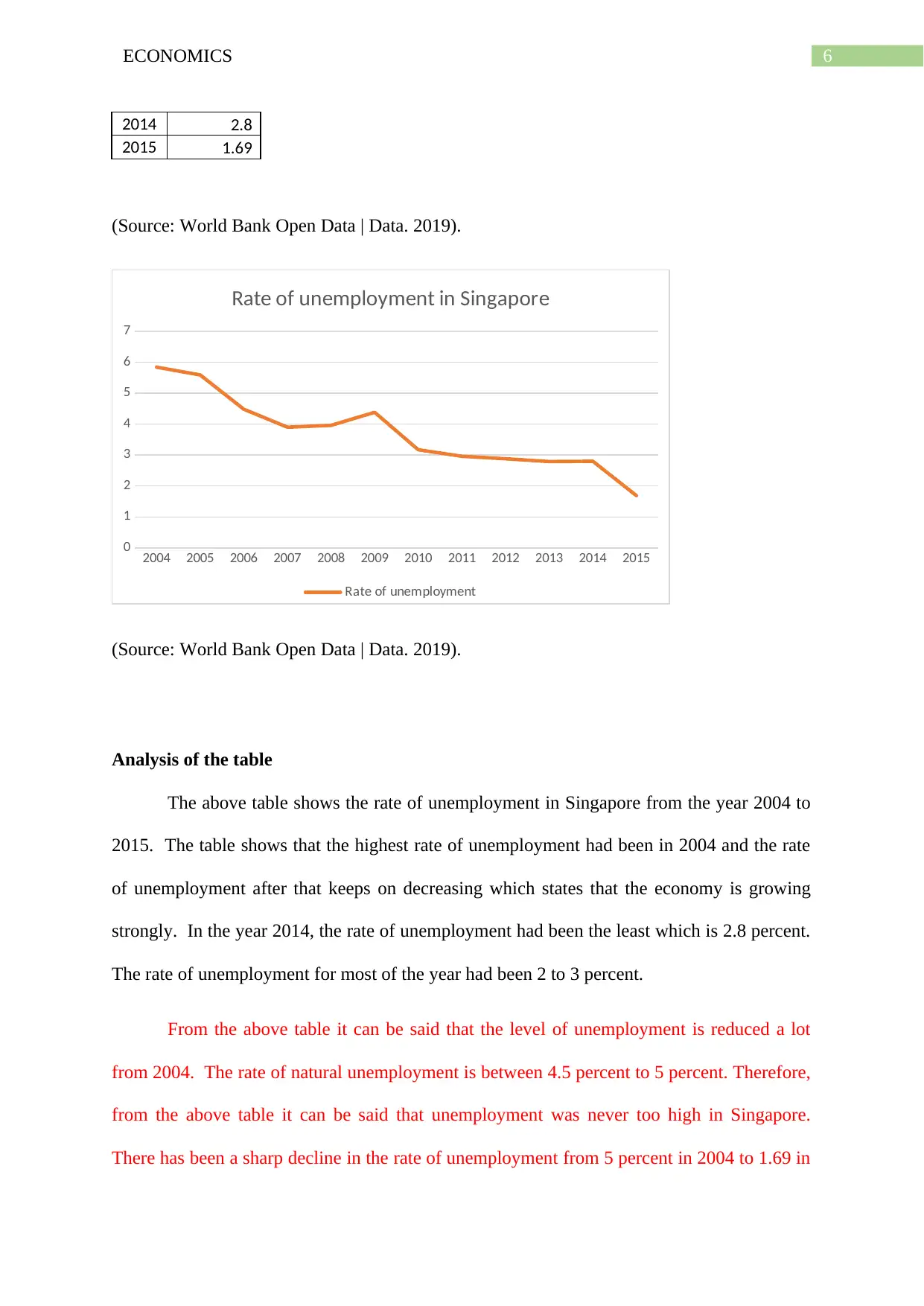
6ECONOMICS
2014 2.8
2015 1.69
(Source: World Bank Open Data | Data. 2019).
2004 2005 2006 2007 2008 2009 2010 2011 2012 2013 2014 2015
0
1
2
3
4
5
6
7
Rate of unemployment in Singapore
Rate of unemployment
(Source: World Bank Open Data | Data. 2019).
Analysis of the table
The above table shows the rate of unemployment in Singapore from the year 2004 to
2015. The table shows that the highest rate of unemployment had been in 2004 and the rate
of unemployment after that keeps on decreasing which states that the economy is growing
strongly. In the year 2014, the rate of unemployment had been the least which is 2.8 percent.
The rate of unemployment for most of the year had been 2 to 3 percent.
From the above table it can be said that the level of unemployment is reduced a lot
from 2004. The rate of natural unemployment is between 4.5 percent to 5 percent. Therefore,
from the above table it can be said that unemployment was never too high in Singapore.
There has been a sharp decline in the rate of unemployment from 5 percent in 2004 to 1.69 in
2014 2.8
2015 1.69
(Source: World Bank Open Data | Data. 2019).
2004 2005 2006 2007 2008 2009 2010 2011 2012 2013 2014 2015
0
1
2
3
4
5
6
7
Rate of unemployment in Singapore
Rate of unemployment
(Source: World Bank Open Data | Data. 2019).
Analysis of the table
The above table shows the rate of unemployment in Singapore from the year 2004 to
2015. The table shows that the highest rate of unemployment had been in 2004 and the rate
of unemployment after that keeps on decreasing which states that the economy is growing
strongly. In the year 2014, the rate of unemployment had been the least which is 2.8 percent.
The rate of unemployment for most of the year had been 2 to 3 percent.
From the above table it can be said that the level of unemployment is reduced a lot
from 2004. The rate of natural unemployment is between 4.5 percent to 5 percent. Therefore,
from the above table it can be said that unemployment was never too high in Singapore.
There has been a sharp decline in the rate of unemployment from 5 percent in 2004 to 1.69 in
⊘ This is a preview!⊘
Do you want full access?
Subscribe today to unlock all pages.

Trusted by 1+ million students worldwide

7ECONOMICS
the year 2015. The labour market have experienced a decline in the rate of unemployment.
The reason is that local jobs have grown in the recent years providing employment.
Unemployment and its types
Unemployment happens when employees who is known to search jobs actively is
unable to find work. It is often used for measuring the economy’s health. The rate of
unemployment is the most frequent measure of unemployment which is known to be
calculated by dividing the number of people who do not have jobs by the number of people
present in the labour force.(Tan & Tang, 2016). The two broadest categories of
unemployment are the involuntary and the voluntary unemployment. In case of voluntary
unemployment, it can be said that the person has left his job willingly and is in search of
other kind of jobs. On the other hand, involuntary unemployment means a person has been
laid off and now he is looking for a job.
There are basically three types of unemployment:
Structural unemployment- this takes place when the skills workers have and the skills
needed by the workers do not match. Structural unemployment can take place due to long
recession.
Frictional unemployment- this kind of unemployment takes place when the employees leave
their old jobs and still did not find the new one (Siddiqui, 2016). This is a short-term
unemployment and is also a natural part of the process of job search.
Seasonal unemployment- this kind of unemployment takes place due to regular changes in
the season.
the year 2015. The labour market have experienced a decline in the rate of unemployment.
The reason is that local jobs have grown in the recent years providing employment.
Unemployment and its types
Unemployment happens when employees who is known to search jobs actively is
unable to find work. It is often used for measuring the economy’s health. The rate of
unemployment is the most frequent measure of unemployment which is known to be
calculated by dividing the number of people who do not have jobs by the number of people
present in the labour force.(Tan & Tang, 2016). The two broadest categories of
unemployment are the involuntary and the voluntary unemployment. In case of voluntary
unemployment, it can be said that the person has left his job willingly and is in search of
other kind of jobs. On the other hand, involuntary unemployment means a person has been
laid off and now he is looking for a job.
There are basically three types of unemployment:
Structural unemployment- this takes place when the skills workers have and the skills
needed by the workers do not match. Structural unemployment can take place due to long
recession.
Frictional unemployment- this kind of unemployment takes place when the employees leave
their old jobs and still did not find the new one (Siddiqui, 2016). This is a short-term
unemployment and is also a natural part of the process of job search.
Seasonal unemployment- this kind of unemployment takes place due to regular changes in
the season.
Paraphrase This Document
Need a fresh take? Get an instant paraphrase of this document with our AI Paraphraser
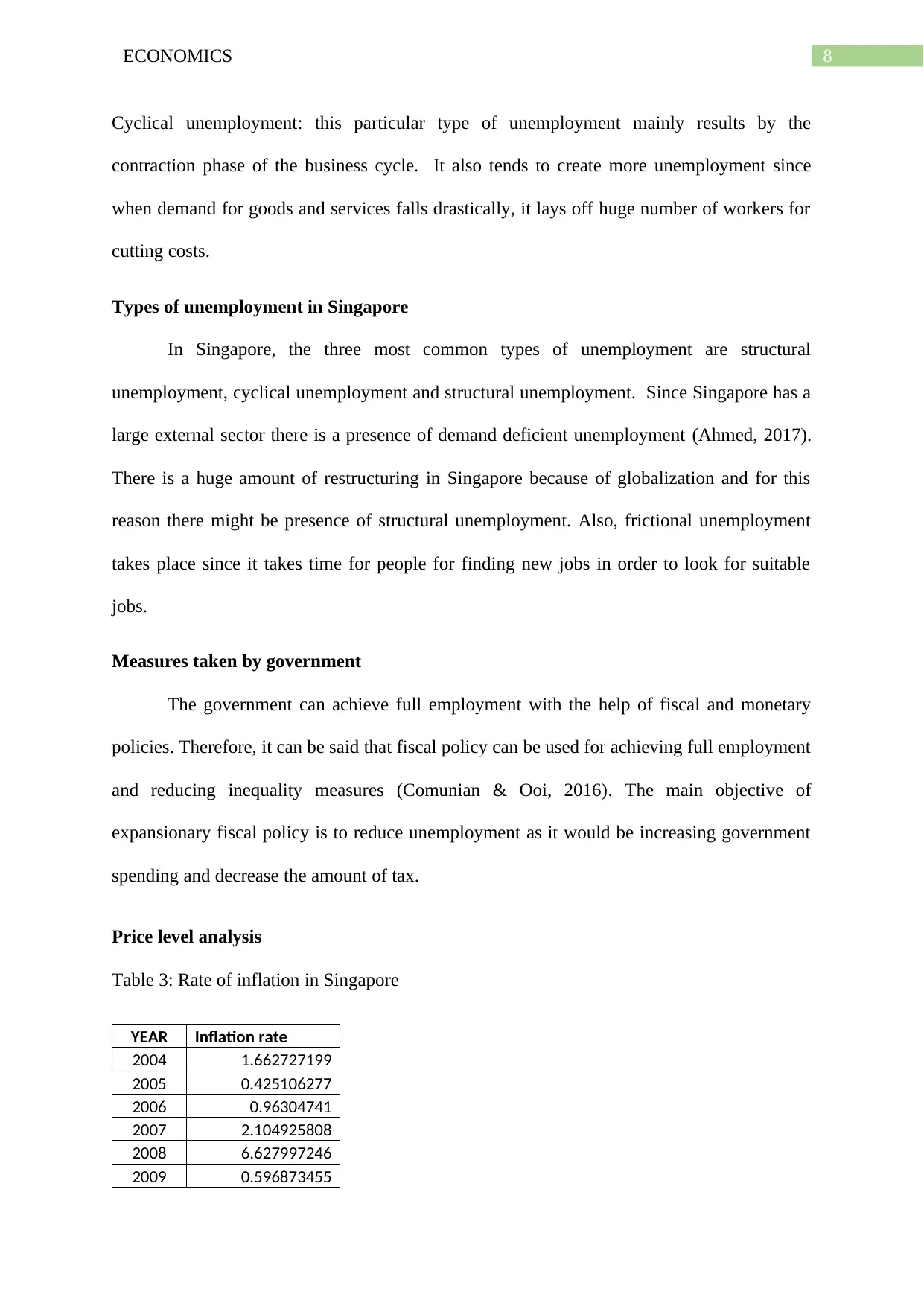
8ECONOMICS
Cyclical unemployment: this particular type of unemployment mainly results by the
contraction phase of the business cycle. It also tends to create more unemployment since
when demand for goods and services falls drastically, it lays off huge number of workers for
cutting costs.
Types of unemployment in Singapore
In Singapore, the three most common types of unemployment are structural
unemployment, cyclical unemployment and structural unemployment. Since Singapore has a
large external sector there is a presence of demand deficient unemployment (Ahmed, 2017).
There is a huge amount of restructuring in Singapore because of globalization and for this
reason there might be presence of structural unemployment. Also, frictional unemployment
takes place since it takes time for people for finding new jobs in order to look for suitable
jobs.
Measures taken by government
The government can achieve full employment with the help of fiscal and monetary
policies. Therefore, it can be said that fiscal policy can be used for achieving full employment
and reducing inequality measures (Comunian & Ooi, 2016). The main objective of
expansionary fiscal policy is to reduce unemployment as it would be increasing government
spending and decrease the amount of tax.
Price level analysis
Table 3: Rate of inflation in Singapore
YEAR Inflation rate
2004 1.662727199
2005 0.425106277
2006 0.96304741
2007 2.104925808
2008 6.627997246
2009 0.596873455
Cyclical unemployment: this particular type of unemployment mainly results by the
contraction phase of the business cycle. It also tends to create more unemployment since
when demand for goods and services falls drastically, it lays off huge number of workers for
cutting costs.
Types of unemployment in Singapore
In Singapore, the three most common types of unemployment are structural
unemployment, cyclical unemployment and structural unemployment. Since Singapore has a
large external sector there is a presence of demand deficient unemployment (Ahmed, 2017).
There is a huge amount of restructuring in Singapore because of globalization and for this
reason there might be presence of structural unemployment. Also, frictional unemployment
takes place since it takes time for people for finding new jobs in order to look for suitable
jobs.
Measures taken by government
The government can achieve full employment with the help of fiscal and monetary
policies. Therefore, it can be said that fiscal policy can be used for achieving full employment
and reducing inequality measures (Comunian & Ooi, 2016). The main objective of
expansionary fiscal policy is to reduce unemployment as it would be increasing government
spending and decrease the amount of tax.
Price level analysis
Table 3: Rate of inflation in Singapore
YEAR Inflation rate
2004 1.662727199
2005 0.425106277
2006 0.96304741
2007 2.104925808
2008 6.627997246
2009 0.596873455
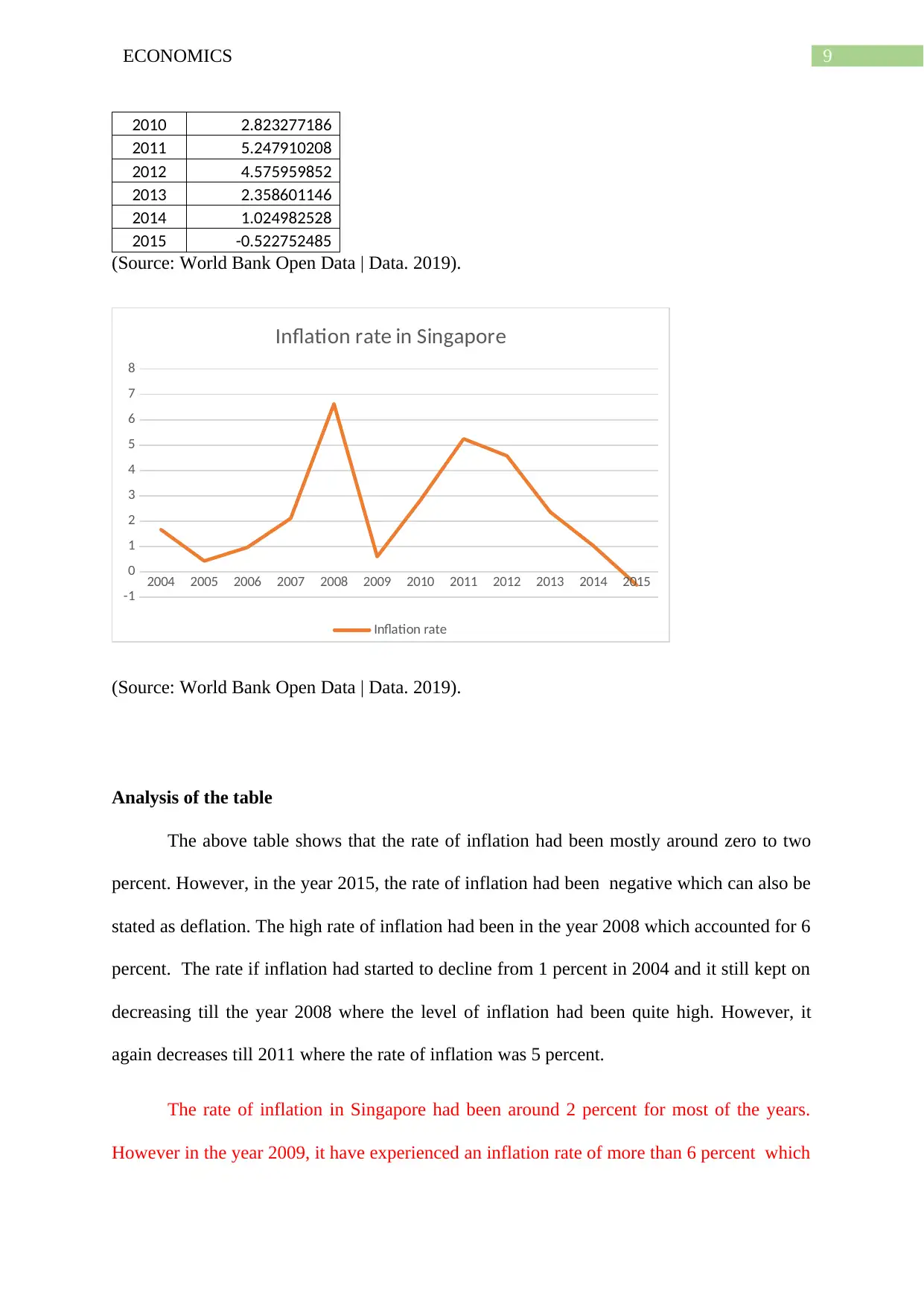
9ECONOMICS
2010 2.823277186
2011 5.247910208
2012 4.575959852
2013 2.358601146
2014 1.024982528
2015 -0.522752485
(Source: World Bank Open Data | Data. 2019).
2004 2005 2006 2007 2008 2009 2010 2011 2012 2013 2014 2015
-1
0
1
2
3
4
5
6
7
8
Inflation rate in Singapore
Inflation rate
(Source: World Bank Open Data | Data. 2019).
Analysis of the table
The above table shows that the rate of inflation had been mostly around zero to two
percent. However, in the year 2015, the rate of inflation had been negative which can also be
stated as deflation. The high rate of inflation had been in the year 2008 which accounted for 6
percent. The rate if inflation had started to decline from 1 percent in 2004 and it still kept on
decreasing till the year 2008 where the level of inflation had been quite high. However, it
again decreases till 2011 where the rate of inflation was 5 percent.
The rate of inflation in Singapore had been around 2 percent for most of the years.
However in the year 2009, it have experienced an inflation rate of more than 6 percent which
2010 2.823277186
2011 5.247910208
2012 4.575959852
2013 2.358601146
2014 1.024982528
2015 -0.522752485
(Source: World Bank Open Data | Data. 2019).
2004 2005 2006 2007 2008 2009 2010 2011 2012 2013 2014 2015
-1
0
1
2
3
4
5
6
7
8
Inflation rate in Singapore
Inflation rate
(Source: World Bank Open Data | Data. 2019).
Analysis of the table
The above table shows that the rate of inflation had been mostly around zero to two
percent. However, in the year 2015, the rate of inflation had been negative which can also be
stated as deflation. The high rate of inflation had been in the year 2008 which accounted for 6
percent. The rate if inflation had started to decline from 1 percent in 2004 and it still kept on
decreasing till the year 2008 where the level of inflation had been quite high. However, it
again decreases till 2011 where the rate of inflation was 5 percent.
The rate of inflation in Singapore had been around 2 percent for most of the years.
However in the year 2009, it have experienced an inflation rate of more than 6 percent which
⊘ This is a preview!⊘
Do you want full access?
Subscribe today to unlock all pages.

Trusted by 1+ million students worldwide
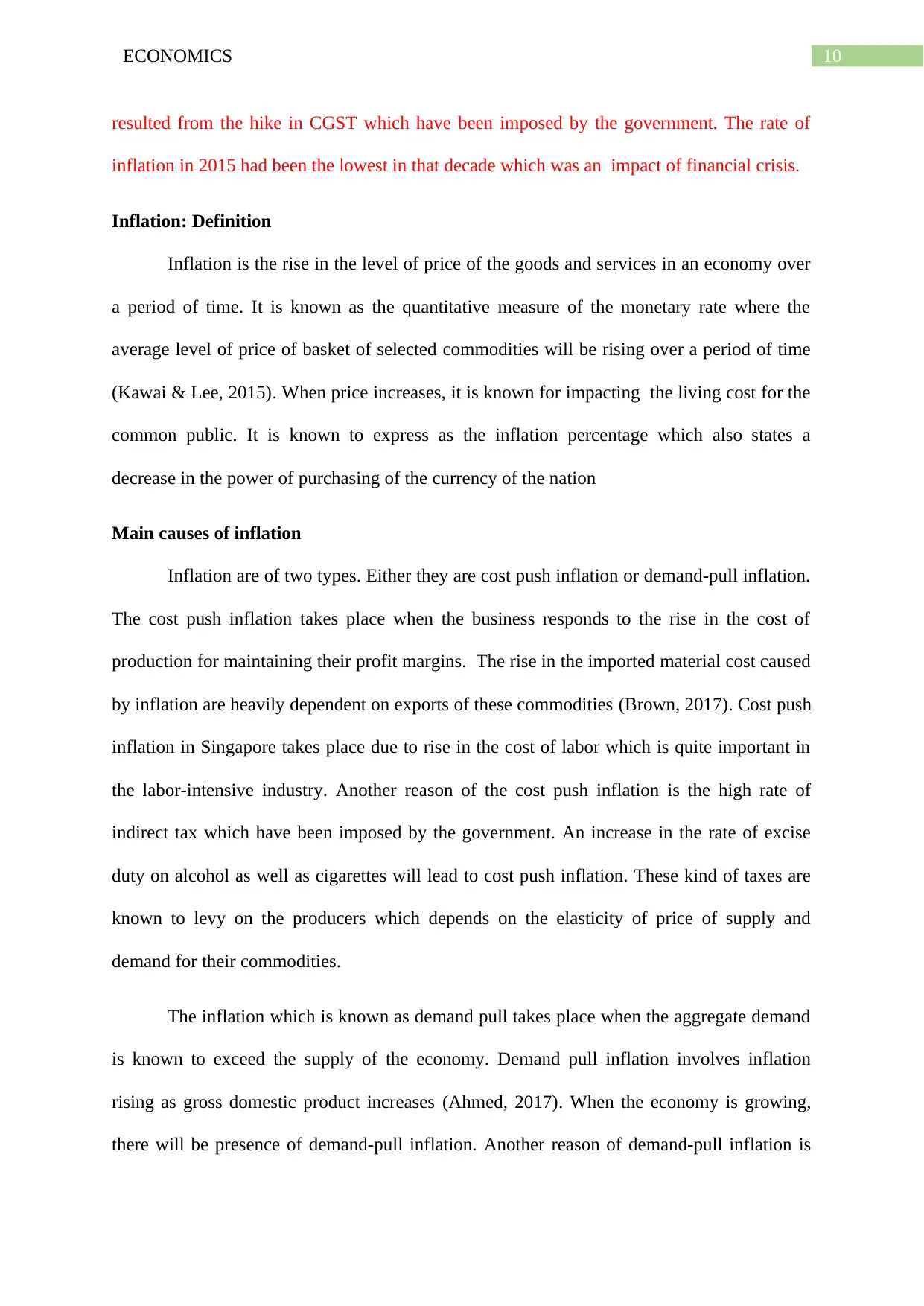
10ECONOMICS
resulted from the hike in CGST which have been imposed by the government. The rate of
inflation in 2015 had been the lowest in that decade which was an impact of financial crisis.
Inflation: Definition
Inflation is the rise in the level of price of the goods and services in an economy over
a period of time. It is known as the quantitative measure of the monetary rate where the
average level of price of basket of selected commodities will be rising over a period of time
(Kawai & Lee, 2015). When price increases, it is known for impacting the living cost for the
common public. It is known to express as the inflation percentage which also states a
decrease in the power of purchasing of the currency of the nation
Main causes of inflation
Inflation are of two types. Either they are cost push inflation or demand-pull inflation.
The cost push inflation takes place when the business responds to the rise in the cost of
production for maintaining their profit margins. The rise in the imported material cost caused
by inflation are heavily dependent on exports of these commodities (Brown, 2017). Cost push
inflation in Singapore takes place due to rise in the cost of labor which is quite important in
the labor-intensive industry. Another reason of the cost push inflation is the high rate of
indirect tax which have been imposed by the government. An increase in the rate of excise
duty on alcohol as well as cigarettes will lead to cost push inflation. These kind of taxes are
known to levy on the producers which depends on the elasticity of price of supply and
demand for their commodities.
The inflation which is known as demand pull takes place when the aggregate demand
is known to exceed the supply of the economy. Demand pull inflation involves inflation
rising as gross domestic product increases (Ahmed, 2017). When the economy is growing,
there will be presence of demand-pull inflation. Another reason of demand-pull inflation is
resulted from the hike in CGST which have been imposed by the government. The rate of
inflation in 2015 had been the lowest in that decade which was an impact of financial crisis.
Inflation: Definition
Inflation is the rise in the level of price of the goods and services in an economy over
a period of time. It is known as the quantitative measure of the monetary rate where the
average level of price of basket of selected commodities will be rising over a period of time
(Kawai & Lee, 2015). When price increases, it is known for impacting the living cost for the
common public. It is known to express as the inflation percentage which also states a
decrease in the power of purchasing of the currency of the nation
Main causes of inflation
Inflation are of two types. Either they are cost push inflation or demand-pull inflation.
The cost push inflation takes place when the business responds to the rise in the cost of
production for maintaining their profit margins. The rise in the imported material cost caused
by inflation are heavily dependent on exports of these commodities (Brown, 2017). Cost push
inflation in Singapore takes place due to rise in the cost of labor which is quite important in
the labor-intensive industry. Another reason of the cost push inflation is the high rate of
indirect tax which have been imposed by the government. An increase in the rate of excise
duty on alcohol as well as cigarettes will lead to cost push inflation. These kind of taxes are
known to levy on the producers which depends on the elasticity of price of supply and
demand for their commodities.
The inflation which is known as demand pull takes place when the aggregate demand
is known to exceed the supply of the economy. Demand pull inflation involves inflation
rising as gross domestic product increases (Ahmed, 2017). When the economy is growing,
there will be presence of demand-pull inflation. Another reason of demand-pull inflation is
Paraphrase This Document
Need a fresh take? Get an instant paraphrase of this document with our AI Paraphraser
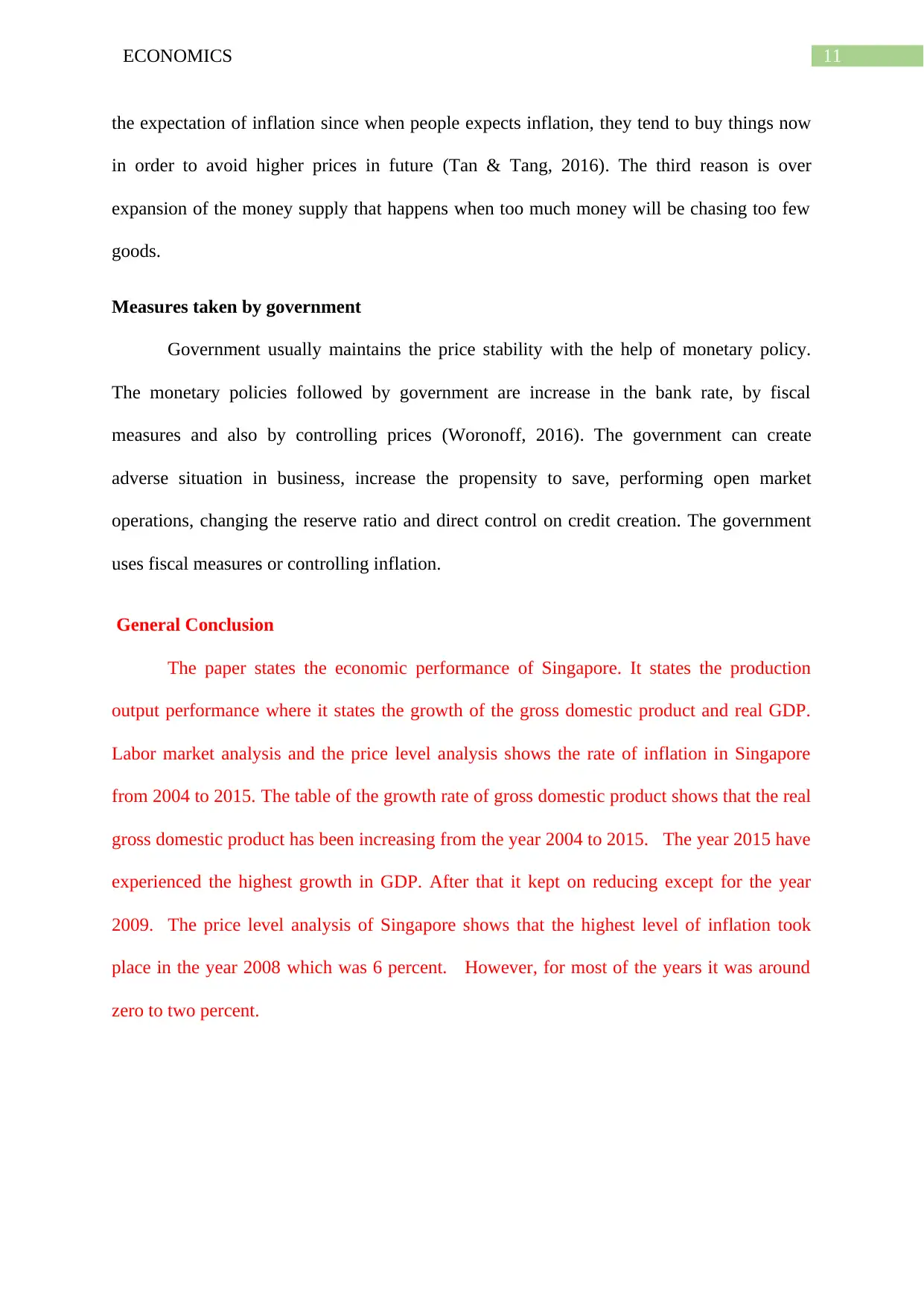
11ECONOMICS
the expectation of inflation since when people expects inflation, they tend to buy things now
in order to avoid higher prices in future (Tan & Tang, 2016). The third reason is over
expansion of the money supply that happens when too much money will be chasing too few
goods.
Measures taken by government
Government usually maintains the price stability with the help of monetary policy.
The monetary policies followed by government are increase in the bank rate, by fiscal
measures and also by controlling prices (Woronoff, 2016). The government can create
adverse situation in business, increase the propensity to save, performing open market
operations, changing the reserve ratio and direct control on credit creation. The government
uses fiscal measures or controlling inflation.
General Conclusion
The paper states the economic performance of Singapore. It states the production
output performance where it states the growth of the gross domestic product and real GDP.
Labor market analysis and the price level analysis shows the rate of inflation in Singapore
from 2004 to 2015. The table of the growth rate of gross domestic product shows that the real
gross domestic product has been increasing from the year 2004 to 2015. The year 2015 have
experienced the highest growth in GDP. After that it kept on reducing except for the year
2009. The price level analysis of Singapore shows that the highest level of inflation took
place in the year 2008 which was 6 percent. However, for most of the years it was around
zero to two percent.
the expectation of inflation since when people expects inflation, they tend to buy things now
in order to avoid higher prices in future (Tan & Tang, 2016). The third reason is over
expansion of the money supply that happens when too much money will be chasing too few
goods.
Measures taken by government
Government usually maintains the price stability with the help of monetary policy.
The monetary policies followed by government are increase in the bank rate, by fiscal
measures and also by controlling prices (Woronoff, 2016). The government can create
adverse situation in business, increase the propensity to save, performing open market
operations, changing the reserve ratio and direct control on credit creation. The government
uses fiscal measures or controlling inflation.
General Conclusion
The paper states the economic performance of Singapore. It states the production
output performance where it states the growth of the gross domestic product and real GDP.
Labor market analysis and the price level analysis shows the rate of inflation in Singapore
from 2004 to 2015. The table of the growth rate of gross domestic product shows that the real
gross domestic product has been increasing from the year 2004 to 2015. The year 2015 have
experienced the highest growth in GDP. After that it kept on reducing except for the year
2009. The price level analysis of Singapore shows that the highest level of inflation took
place in the year 2008 which was 6 percent. However, for most of the years it was around
zero to two percent.
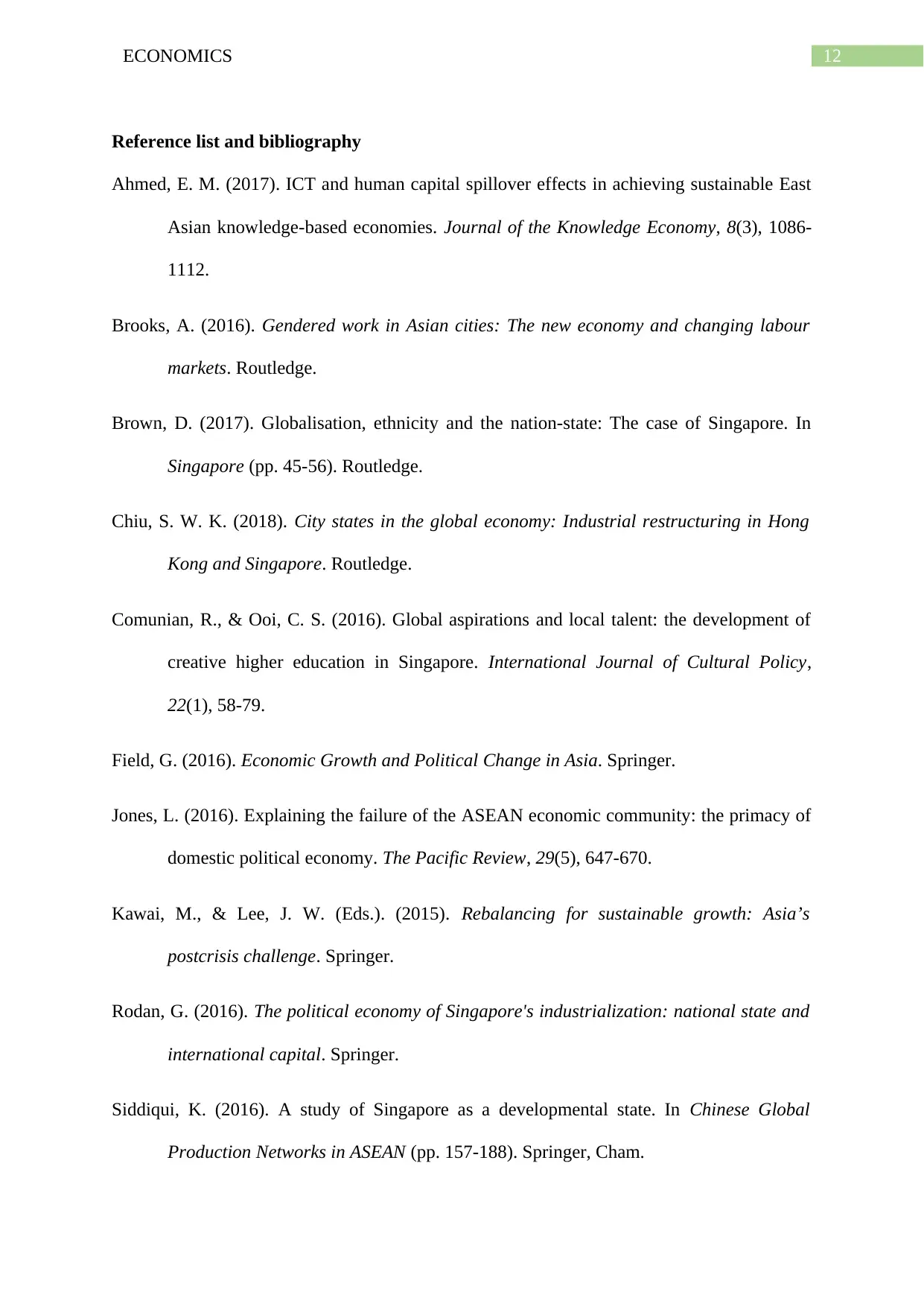
12ECONOMICS
Reference list and bibliography
Ahmed, E. M. (2017). ICT and human capital spillover effects in achieving sustainable East
Asian knowledge-based economies. Journal of the Knowledge Economy, 8(3), 1086-
1112.
Brooks, A. (2016). Gendered work in Asian cities: The new economy and changing labour
markets. Routledge.
Brown, D. (2017). Globalisation, ethnicity and the nation-state: The case of Singapore. In
Singapore (pp. 45-56). Routledge.
Chiu, S. W. K. (2018). City states in the global economy: Industrial restructuring in Hong
Kong and Singapore. Routledge.
Comunian, R., & Ooi, C. S. (2016). Global aspirations and local talent: the development of
creative higher education in Singapore. International Journal of Cultural Policy,
22(1), 58-79.
Field, G. (2016). Economic Growth and Political Change in Asia. Springer.
Jones, L. (2016). Explaining the failure of the ASEAN economic community: the primacy of
domestic political economy. The Pacific Review, 29(5), 647-670.
Kawai, M., & Lee, J. W. (Eds.). (2015). Rebalancing for sustainable growth: Asia’s
postcrisis challenge. Springer.
Rodan, G. (2016). The political economy of Singapore's industrialization: national state and
international capital. Springer.
Siddiqui, K. (2016). A study of Singapore as a developmental state. In Chinese Global
Production Networks in ASEAN (pp. 157-188). Springer, Cham.
Reference list and bibliography
Ahmed, E. M. (2017). ICT and human capital spillover effects in achieving sustainable East
Asian knowledge-based economies. Journal of the Knowledge Economy, 8(3), 1086-
1112.
Brooks, A. (2016). Gendered work in Asian cities: The new economy and changing labour
markets. Routledge.
Brown, D. (2017). Globalisation, ethnicity and the nation-state: The case of Singapore. In
Singapore (pp. 45-56). Routledge.
Chiu, S. W. K. (2018). City states in the global economy: Industrial restructuring in Hong
Kong and Singapore. Routledge.
Comunian, R., & Ooi, C. S. (2016). Global aspirations and local talent: the development of
creative higher education in Singapore. International Journal of Cultural Policy,
22(1), 58-79.
Field, G. (2016). Economic Growth and Political Change in Asia. Springer.
Jones, L. (2016). Explaining the failure of the ASEAN economic community: the primacy of
domestic political economy. The Pacific Review, 29(5), 647-670.
Kawai, M., & Lee, J. W. (Eds.). (2015). Rebalancing for sustainable growth: Asia’s
postcrisis challenge. Springer.
Rodan, G. (2016). The political economy of Singapore's industrialization: national state and
international capital. Springer.
Siddiqui, K. (2016). A study of Singapore as a developmental state. In Chinese Global
Production Networks in ASEAN (pp. 157-188). Springer, Cham.
⊘ This is a preview!⊘
Do you want full access?
Subscribe today to unlock all pages.

Trusted by 1+ million students worldwide
1 out of 13
Related Documents
Your All-in-One AI-Powered Toolkit for Academic Success.
+13062052269
info@desklib.com
Available 24*7 on WhatsApp / Email
![[object Object]](/_next/static/media/star-bottom.7253800d.svg)
Unlock your academic potential
Copyright © 2020–2025 A2Z Services. All Rights Reserved. Developed and managed by ZUCOL.





